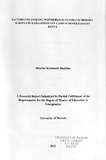| dc.description.abstract | Girls' participation in education in refugee camps has been found to very low as compared to boys. Secondly, the performance of girls has also been found be far below that of boys. The current influx of refugees in Dadaab due to the war crisis in Somalia has seen an enormous influx of refugees from war zones that have led to tremendous increase in the population in Dadaab refugee camps consequently worsening the already bad situation. This study therefore sought to establish the factors affecting the performance of girls in Dadaab Refugee camp in Garissa County, Kenya.
The study aimed at finding out the family, the school, the camp and girl related factors that affect the performance of girls in Dadaab refugee camp. Literature has shown that girls in refugee camps do not perform as the boys as well as other students not in camps. Factors identified for this were grouped into camp, school, family and personal (girl) related factors.
The data was collected from teachers in the schools as well as girls in the camp schools. Data was collected using questionnaires and observation schedules and their reliability tested using Cronbach's alpha value. The questionnaires had Cronbach's alpha values of 0.81 and 0.78 for teachers and pupils respectively. Descriptive statistics were used to analyse quantitative data on rating of the factors while inferential statistics (the independent sample t-test) was used to test the effect of selected factors on the girls' performance. Qualitative data was analyzed thematically according to the objectives.
The family factors identified were: low education level of parents, harsh home environments, and traditional values such as early marriage, FGM and family chores. The significant school related factors were: poor school attendance unfavourable or gender insensitive school environments, inadequacy of trained teachers, physical facilities and instructional materials. The camp related factors included lack of adequate humanitarian assistance for the girls, inadequate health facilities, food, water and sanitary facilities such as toilets and sanitary towels are common. For the girl factors negative attitude of the girls towards education and low motivation and lack of concentration in school were the key factors camp, school and girl related factors were all found to have some negative effects on girl child performance.
The researcher recommended government intervention in creation of awareness on girl child education, provision of security and other humanitarian assistance. The results of t-test showed that role models had significant effects on girls' performance (17.4%) while parental level of education had stronger influence (23.6%).
Based on these findings the researcher recommended that: Parents should be sensitized on the importance of girl child education, the detrimental effects of FGM and early marriage to their daughters so as to help change their attitudes.
The government in partnership with international organizations should strive to create safe conducive home environments in camps by expanding the camp capacity through building more houses, provision of lighting, adequate water and sanitation facilities among others. The study did not address boy child education, the psychological effects of war on the girls thus the researcher suggests this for further studies. | en_US |

